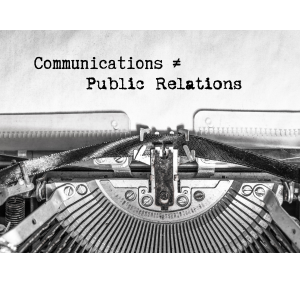I debated tackling this topic because I have a strong background in Public Relations (PR) and I don’t want to diminish the value of PR, but I’ve seen too many businesses misunderstand the differences or lump Communications and PR together, to their detriment.

Technically, the definition of Public Relations is “a strategic communication process that builds mutually beneficial relationships between organizations and their publics” so it makes sense that PR would sit inside Communications, but my issue is not so much how PR pros understand the differences, it’s how most business leaders don’t understand it.
Raise your hand if you believe that PR is about getting media coverage.
If you mentally (or physically) raised a hand, you’re not wrong, per say. In practice, media relations tends to be a large part of how PR programs are executed. After that, you’ll see government relations or ‘public affairs,’ as it’s commonly known and then maybe content and social included, but usually it’s using those channels to amplify the news coverage.
Communications is much broader.
While there are a lot of very correct ways to think about it, I break down Communications into three pillars:
- Internal
- Customer
- Reputation
The three are deeply interconnected, but in my experience companies glaze over the first two when thinking about their Comms programs. Which sucks because they are missing out on key audiences and programs that can move the profitability, growth, and net retention needles. Also, by limiting the investment in Communications to only PR, businesses introduce risk into their organizations.
Here are some examples:
Customer Communications: Voice of the Customer programs or Advisory Council/Board programs rely on purposefully-designed and disciplined communications to be successful and Customer Success teams will need the support of Comms to execute these types of programs.
Internal Communications: Leaders and boards spend a lot of time and energy on annual plans, developing the strategies and resources to hit their targets. But a strategy that isn’t communicated well will not be executed. And keeping people aligned and executing takes far more than a town hall and targets listed in a project management tool.
When investing in communications make sure that you’re seeing the whole opportunity landscape and mapping to organizational objectives and resources. If you need help with this, get your head of comms to weigh in, ask your PR agency lead for how to expand the thinking, or work with a fractional comms leader/consultant to identify the right balance of Comms strategies.




